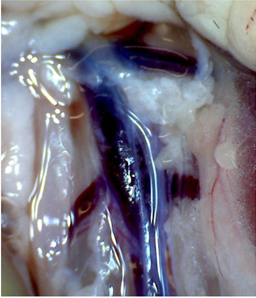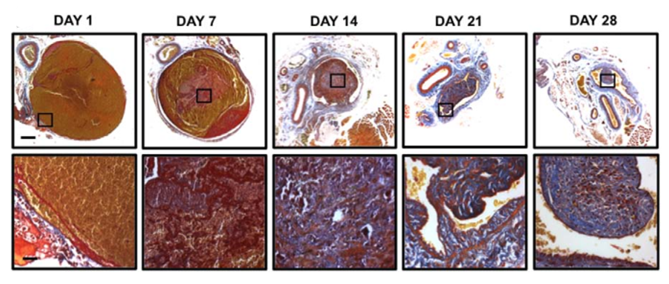Venous Thrombosis Model
Venous thrombosis (VT) is a common clinical condition worldwide and related to high mortality rate. The etiology of VT is multifactorial and mainly involved with genetics, venous endothelial injury, hypercoagulabilitya and venous stasis. The injury of vein wall, the release of inflammatory cells and coagulation factors as well as their interaction all lead to the occurrence of VT. At present, systemic anticoagulation and catheter-directed thrombolysis are the main strategies to treat venous thrombosis. However, the specific pathogenesis of VT has not been completely understood.
Creative Bioarray specializes in providing customized pharmacodynamic research services to help customers assess the efficacy of drug candidates and study the associated pathological mechanisms through VT models.
Models available
- Ferric chloride induced venous injury
- Inferior vena cava stasis or ligation model
- Electrolytic stimulation model
- Inferior vena cava stenosis model
Species available
- Mouse
- Rat
- Rabbit
Our Capabilities
- We estimate the thrombus size by counting the pathological staining area.
Assays available
- Thrombus weight measurement
- Histopathological evaluation
- Magnetic resonance imaging
- Biochemical analysis
With extensive experience in the field of venous thrombosis, we are confident to help you overcome any upcoming challenges. Our experts are fully capable of customizing our protocols and assays to meet your specific needs. With our help, we wish to facilitate your research with high efficiency.
Study examples
 Figure. 1. The inferior vena cava is the most commonly used vessel in the venous thrombosis model. The segment caudal to the left renal vein is used. Anatomical variations in the number of side branches in this area are common.
Figure. 1. The inferior vena cava is the most commonly used vessel in the venous thrombosis model. The segment caudal to the left renal vein is used. Anatomical variations in the number of side branches in this area are common.
 Figure. 2. Representative micrographs of trans-verse thrombus sections stained with Martius scarlet blue (MSB) at days 1, 7, 14, 21, and 28 post induction. MSB detects collagen (blue), fibrin (red), and erythrocytes (yellow); scale bars, 200 µm (low power) and 25 µm (high power).
Figure. 2. Representative micrographs of trans-verse thrombus sections stained with Martius scarlet blue (MSB) at days 1, 7, 14, 21, and 28 post induction. MSB detects collagen (blue), fibrin (red), and erythrocytes (yellow); scale bars, 200 µm (low power) and 25 µm (high power).
Quotation and ordering
If you have any special needs or questions regarding our services, please feel free to contact us. We look forward to cooperating with you in the future.
References
Schönfelder, S. Jäckel, P. Wenzel. Mouse models of deep vein thrombosis[J]. Gefässchirurgie, 2017.
Grover S P , Evans C E , Patel A S , et al. Assessment of Venous Thrombosis in Animal Models[J]. Arteriosclerosis Thrombosis and Vascular Biology, 2015, 36(2):245.
For research use only. Not for any other purpose.
Disease Models
- Oncology Models
-
Inflammation & Autoimmune Disease Models
- Rheumatoid Arthritis Models
- Glomerulonephritis Models
- Multiple Sclerosis (MS) Models
- Ocular Inflammation Models
- Sjögren's Syndrome Model
- LPS-induced Acute Lung Injury Model
- Peritonitis Models
- Passive Cutaneous Anaphylaxis Model
- Delayed-Type Hypersensitivity (DTH) Models
- Inflammatory Bowel Disease Models
- Systemic Lupus Erythematosus Animal Models
- Oral Mucositis Model
- Asthma Model
- Sepsis Model
- Psoriasis Model
- Atopic Dermatitis (AD) Model
- Scleroderma Model
- Gouty Arthritis Model
- Carrageenan-Induced Air Pouch Synovitis Model
- Carrageenan-Induced Paw Edema Model
- Experimental Autoimmune Myasthenia Gravis (EAMG) Model
- Graft-versus-host Disease (GvHD) Models
-
Cardiovascular Disease Models
- Surgical Models
- Animal Models of Hypertension
- Venous Thrombosis Model
- Atherosclerosis model
- Cardiac Arrhythmia Model
- Hyperlipoidemia Model
- Doxorubicin-induced Heart Failure Model
- Isoproterenol-induced Heart Failure Model
- Arterial Thrombosis Model
- Pulmonary Arterial Hypertension (PAH) Models
- Heart Failure with Preserved Ejection Fraction (HFpEF) Model
-
Neurological Disease Models
- Alzheimer's Disease Modeling and Assays
- Seizure Models
- Parkinson's Disease Models
- Ischemic Stroke Models
- Acute Spinal Cord Injury (ASCI) Model
- Traumatic Brain Injury (TBI) Model
- Hypoxic-Ischemic Encephalopathy (HIE) Model
- Tourette Syndrome (TS) Model
- Amyotrophic Lateral Sclerosis (ALS) Model
- Huntington's Disease (HD) Model
- Intracerebral hemorrhage (ICH) Models
- Schizophrenia Model
- Pain Models
-
Metabolic Disease Models
- Type 1 Diabetes Mellitus Model
- Type 2 Diabetes Mellitus Model
- Animal Model of Hyperuricemia
-
Nonalcoholic Fatty Liver Disease Model
- High-Fat Diet-Induced Nonalcoholic Fatty Liver Disease (NAFLD) Model
- Methionine and Choline Deficient (MCD) Diet-Induced Nonalcoholic Fatty Liver Disease (NAFLD) Model
- Gubra-Amylin NASH (GAN) Diet-Induced Nonalcoholic Fatty Liver Disease (NAFLD) Model
- Streptozotocin (STZ) Induced Nonalcoholic Fatty Liver Disease (NAFLD) Model
- High Fat Diet-Induced Obesity Model
- Diabetic Foot Ulcer (DFU) Model
- Liver Disease Models
- Rare Disease Models
- Respiratory Disease Models
- Digestive Disease Models
-
Urology Disease Models
- Cisplatin-induced Nephrotoxicity Model
- Unilateral Ureteral Obstruction Model
- 5/6 Nephrectomy Model
- Renal Ischemia-Reperfusion Injury (RIRI) Model
- Diabetic Nephropathy (DN) Models
- Passive Heymann Nephritis (PHN) Model
- Adenine-Induced Chronic Kidney Disease (CKD) Model
- Kidney Stone Model
- Doxorubicin-Induced Nephropathy Model
- Orthotopic Kidney Transplantation Model
- Orthopedic Disease Models
- Ocular Disease Models
- Skin Disease Models
- Infectious Disease Models
- Otology Disease Models